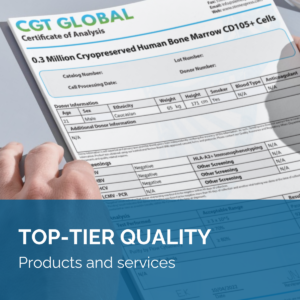Fresh or Frozen Primary Cells: Which one should I choose?
Deciding to purchase fresh or frozen primary cells may not be as simple as you think. There are many factors that may influence your decision, such as cell type, cell functionality, and logistical and timing flexibility. We hope that the following article provides the information you require to make a decision in choosing fresh or frozen primary cells for your specific research.
Fresh Cells
At StemExpress, fresh cells are offered as whole blood items, such as a Leukopak or bone marrow aspirate, and are collected the day the donor arrives at one of our strategically located Stem Cell Collection Centers. If the desired cell population is requested, the whole blood item is quickly sent to our on-site laboratory where the cell population is isolated and placed in a cell-friendly medium to preserve viability and functionality. The items, whether a whole blood item or isolated primary cell type, are shipped to our customers the same day of collection or by next day delivery at ambient temperature.
Why choose fresh cells?
The cellular function of viable cells can be influenced by dead or dying cells.
The majority of human cell types are directly influenced by their immediate environment due to the wide variety of receptors located on the exterior of their cell membrane, therefore, the presence of debris from dead and dying cells can have a significant effect on the cellular processes of neighboring viable cells. Consequently, changes in the cellular processes of viable cells can have an adverse effect on cellular experiments and assays.
Fresh cells are more viable and, therefore, are better when studying rare populations.
Depending on the thawing protocol used, viability can decline by 10% to 15% post-thaw. This can lead to a greater impact on rare cell populations, such as CD34+ stem cells or regulatory T cells, that account for roughly 0.2% and 1% of the total leukocyte population.
The freeze/thaw procedure can impact cell function of some cells.
A study by Ramachandran et al. showed a reduction in CD4 cell functionality when exposed to DMSO during the thawing protocol for a long period of time. Additionally, in a separate study by Silveira et al., the authors presented data suggesting an impaired function of immature DCs generated from cryopreserved monocytes.
The length of storage in a frozen state can impact cell function of some cells.
In an article by Wilkening et al., frozen PBMCs from HIV-infected donors showed a correlation in the decrease of viability and recovery with the duration of storage time. However, this effect was not seen in frozen normal PBMCs.
Variations in the thawing protocols can change the outcome of cell viability.
Minor variations in the thawing protocol can have a significant impact on cell viability. In an article by Cox et al., eleven separate laboratories thawed identical PBMC samples according to their in-house procedure. The median viability for all samples was 86%, respectively, with a wide range from 24.8% to 100%.
Frozen Cells
Successful cryopreservation of cells requires not only that the cells be handled in a proper fashion for harvesting with equipment in place to ensure consistency, reproducibility, and sterility, but also that a suitable cryoprotective agent is added. At StemExpress we use a controlled rate freezer that freezes at a rate of 1°C/min and a 10% DMSO cryoprotectant solution, which is necessary to retain optimal viability of human primary cells. In addition, frozen cells are stored in a vapor phase nitrogen cryopreservation container.
Cryopreservation is the process by which intact living cells are preserved at cryogenic temperatures in the vapor phase of liquid nitrogen in the presence of a cryoprotectant. This process allows the cells to be stored, often for years, in a state of normal metabolic arrest in order to protect them from damage due to chemical reactivity and time. The cells can then be thawed and revived as needed.
Why choose frozen cells?
Frozen cells provide convenience in the timing of your experiment.
Fresh cells must be used immediately and can create an inconvenience for future downstream projects. Frozen cells can be used on consecutive experiments over the length of a project, which can take months, and even years, to complete.
Cell function can change due to donor-to-donor variability.
In instances were downstream projects may be necessary for the analysis of your specific cell type, frozen cells offer the convenience of purchasing large lots from the same donor, which eliminates donor-to-donor variability. In an article by Siegel et al., the authors showed that mesenchymal stem cells isolated from 53 donors with varying ages and gender (25 females, 28 males; age: 13-80 years) had an effect on cell phenotype and function.
Vapor phase of liquid nitrogen significantly reduces the risk of cross-contamination.
Cells stored in the vapor phase of liquid nitrogen prevent cross-contamination by viral pathogens as compared to liquid nitrogen containers. While stored in the vapor phase, the frozen cells do not come into contact with the liquid nitrogen. In a case reported by Tedder et al., six transfused patients undergoing cytotoxic treatment for malignant disorders became infected with the hepatitis B virus (HBV). It was later determined that the hepatitis B transmission came from the liquid nitrogen in a single cryopreservation tank.
Frozen cells allow logistical flexibility in your research.
The ability to ship frozen cells for analysis at another site allows for efficient batch-testing of multiple samples in large-scale assays across multiple sites and platforms over extended time periods.
Ideal for longitudinal studies of common or frequent cell populations.
When analyzing cell populations that make-up >5% of the leukocyte population, such as CD3 T cells or monocytes, a small decline in viability due to the freeze/thaw procedure does not impact these more robust populations due to their sheer number as compared to rare cells.
At StemExpress we strive to keep your research moving forward. We offer a wide assortment of fresh or frozen primary cells from bone marrow, cord blood, peripheral blood, mobilized peripheral blood, and diseased blood. If you have any concerns or questions regarding fresh or frozen primary cells, we are here to assist you. Contact Us today!
References
Ramachandran et al. (2012). Optimal Thawing of Cryopreserved Peripheral Blood Mononuclear Cells for Use in High-Throughput Human Immune Monitoring Studies. Cell. 1(3): 313–324. Abstract.
Silveira et al. (2013). Immature Dendritic Cells Generated from Cryopreserved Human Monocytes Show Impaired Ability to Respond to LPS and to Induce Allogeneic Lymphocyte Proliferation. PlosOne. Abstract.
Weinberg et al. (2010). Optimization of Storage and Shipment of Cryopreserved Peripheral Blood Mononuclear Cells from HIV-Infected and Uninfected Individuals for ELISPOT Assays. Immunol Methods. 363(1): 42-50. Abstract.
Cox et al. (2005). Results of an ELISPOT Proficiency Panel Conducted in 11 Laboratories Participating in International Human Immunodeficiency Virus Type 1 Vaccine Trials. AIDS Res Hum Retroviruses. 21(1): 68-81. Abstract.
Tedder et al. (1995). Hepatitis B Transmission from Contaminated Cryopreservation Tank. The Lancet. 368(8968): 137-140. Abstract.
Siegel et al. (2013). Phenotype, Donor Age and Gender Affect Function of Human Bone Marrow-Derived Mesenchymal Stromal Cells. BMC Medicine. 11:146. Article.







